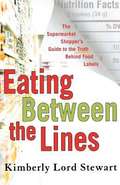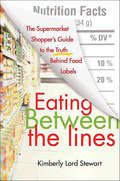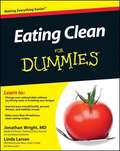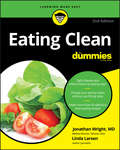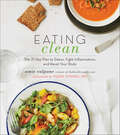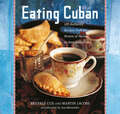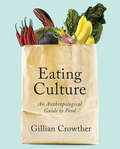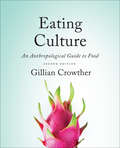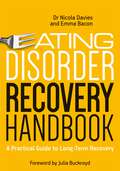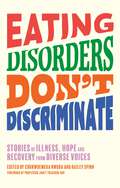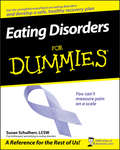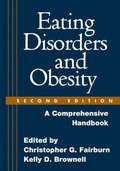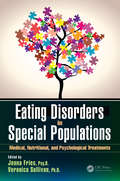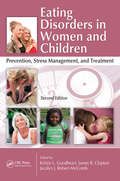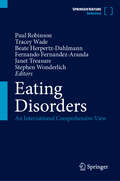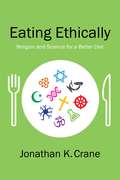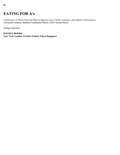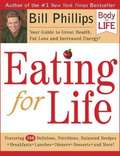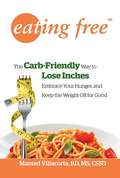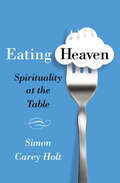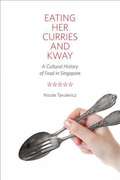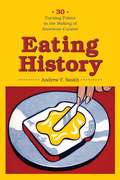- Table View
- List View
Eating Between The Lines: The Supermarket Shopper's Guide to the Truth Behind Food Labels
by Kimberly Stewart<p>So many labels, so little time—just tell me what to buy! <p>If you—like millions of other Americans—still don't know how to read food labels and are frustrated by the hundreds of nutrition and health claims as well as statements like free-range and grassfed, it's time to learn what you're really putting into your body...find out how to select the most healthy foods at the supermarket and still get dinner on the table by 6:00 pm with EATING BETWEEN THE LINES <p>Shopping is no longer as simple as deciding what's for dinner. Food labels like "organic," "natural," "low carb," and "fat free!" scream out at you from every aisle at the supermarket. Some claims are certified by authoritative groups such as the FDA and USDA, but much of our country's nutrition information is simply a marketing ploy. If you want to know what food labels really mean—and what they could mean to your health—EATING BETWEEN THE LINES will explain why.</p>
Eating Between the Lines: The Supermarket Shopper's Guide to the Truth Behind Food Labels
by Kimberly Lord StewartSo many labels, so little time—just tell me what to buy!If you—like millions of other Americans—still don't know how to read food labels and are frustrated by the hundreds of nutrition and health claims as well as statements like free-range and grassfed, it's time to learn what you're really putting into your body…find out how to select the most healthy foods at the supermarket and still get dinner on the table by 6:00 pm with EATING BETWEEN THE LINESShopping is no longer as simple as deciding what's for dinner. Food labels like "organic," "natural," "low carb," and "fat free!" scream out at you from every aisle at the supermarket. Some claims are certified by authoritative groups such as the FDA and USDA, but much of our country's nutrition information is simply a marketing ploy. If you want to know what food labels really mean—and what they could mean to your health—EATING BETWEEN THE LINES will explain why:--Chickens labeled "free range" may never actually see daylight --Organic seafood may be a misnomer. --The words "hormone-free" on pork, eggs and poultry is meaningless --"Low fat" cookies and "heart-healthy" cereals may contain heart damaging trans-fatty acids …and more. Organized by supermarket section, from the vegetable aisle to the dairy case, EATING BETWEEN THE LINES also features more than seventy actual food labels and detachable shopping lists for your convenience—and to help bring the best food to the table for you and your family.
Eating Chinese
by Lily Cho"Chicken fried rice, sweet and sour pork, and an order of onion rings, please."Chinese restaurants in small town Canada are at once everywhere - you would be hard pressed to find a town without a Chinese restaurant - and yet they are conspicuously absent in critical discussions of Chinese diasporic culture or even in popular writing about Chinese food. In Eating Chinese, Lily Cho examines Chinese restaurants as spaces that define, for those both inside and outside the community, what it means to be Chinese and what it means to be Chinese-Canadian.Despite restrictions on immigration and explicitly racist legislation at national and provincial levels, Chinese immigrants have long dominated the restaurant industry in Canada. While isolated by racism, Chinese communities in Canada were still strongly connected to their non-Chinese neighbours through the food that they prepared and served. Cho looks at this surprisingly ubiquitous feature of small-town Canada through menus, literature, art, and music. An innovative approach to the study of diaspora, Eating Chinese brings to light the cultural spaces crafted by restaurateurs, diners, cooks, servers, and artists.
Eating Clean For Dummies
by Linda Larsen Bs Dr Jonathan Wright BaThe fast and easy way to eat clean Clean foods are natural; free of added sugars, hydrogenated fats, trans-fats, and anything else that is unnatural and unnecessary. Used as a way of life, clean eating can improve overall health, prevent disease, increase energy, and stabilize moods. Whether you've lived on white bread and trans fats all your life and are looking to clean-up your diet, or are already health conscious, Eating Clean For Dummies embraces this lifestyle and provides you with an easy-to-follow guide to a clean-eating diet, recipes, and budgeting. The foundation of the clean eater's diet More than 40 clean-eating recipes Tips on how to change your eating habits without sacrificing taste or breaking your budget Tips to bring the whole family (even kids) on the path to a clean lifestyle If you're part of the growing population of consumers coming to the realization of the harmful impacts that highly processed and unnatural foods have on your body, or are taking preventive measures to avoid metabolic syndromes and diabetes, this is your hands-on, friendly guide to clean-eating diet, recipes, and budgeting.
Eating Clean For Dummies
by Jonathan Wright Linda LarsenThe fast and easy way to eat clean Clean foods are natural; free of added sugars, hydrogenated fats, trans-fats, and anything else that is unnatural and unnecessary. Used as a way of life, clean eating can improve overall health, prevent disease, increase energy, and stabilize moods. Whether you've lived on white bread and trans fats all your life and are looking to clean-up your diet, or are already health conscious, Eating Clean For Dummies embraces this lifestyle and provides you with an easy-to-follow guide to a clean-eating diet, recipes, and budgeting. The foundation of the clean eater's diet More than 40 clean-eating recipes Tips on how to change your eating habits without sacrificing taste or breaking your budget Tips to bring the whole family (even kids) on the path to a clean lifestyle If you're part of the growing population of consumers coming to the realization of the harmful impacts that highly processed and unnatural foods have on your body, or are taking preventive measures to avoid metabolic syndromes and diabetes, this is your hands-on, friendly guide to clean-eating diet, recipes, and budgeting.
Eating Clean: The 21-Day Plan to Detox, Fight Inflammation, and Reset Your Body
by Amie ValponeThe essential guide to fight inflammation, heal your gut, and reset your body with detox and clean eating After suffering for a decade from a range of ailments like Lyme Disease, Hypothyroidism, and Leaky Gut Syndrome, Amie Valpone, creator of TheHealthyApple.com, healed herself through clean eating and detoxing. In Eating Clean, Amie provides guidance on how to fight inflammation and reset your body, including a 21-Day Elimination Diet, instructions for food reintroduction, a 2-week meal plan, and an extensive pantry list. The book has over 200 recipes that are vegetarian and free of gluten, dairy, soy, corn, eggs, and refined sugar to keep tummies healthy and satisfied—such as Velvety Pear and Fennel Soup, Carrot &“Fettuccine&” with Sun-Dried Tomatoes and Pumpkin Seeds, and Vanilla Bean Coconut Ice Cream. With this book, readers are able to get the support they need on their path toward wellness.
Eating Cuban: 120 Authentic Recipes from the Streets of Havana to American Shores
by Martin Jacobs Beverly CoxTo “eat Cuban” is to savor a deliciously complex culinary culture. Spanish, Native American, African, Chinese, and French traditions have all contributed to Cuban cooking, producing a distinctive Caribbean cuisine as richly chorded as the island’s music. Beverly Cox and Martin Jacobs’s itinerary takes them from the barrio, paladars (private restaurants), and chic nightspots of Havana to the eateries of Florida’s emigré communities. From their journeys, they’ve gathered more than 120 recipes that comprehensively document Cuban cooking’s diversity, from the black bean soup found on any Cuban table, to the empanadas sold by Havana’s street vendors, to the grilled sandwiches that are a mainstay of Miami’s Calle Ocho, to the innovative dishes devised by chefs at top Cuban restaurants. Gorgeously illustrated with Jacobs’s photographs —many shot on the authors’ travels through Cuba—Eating Cuban highlights Cuban food’s historical roots, the classic Creole dishes that evolved from these disparate cultural influences, current trends in Cuban cooking, street foods and on-the-go snacks, and quintessential Cuban beverages from café Cubano to the mojito. A valuable resource list helps American cooks locate the required ingredients, and a restaurant directory points the way to the very best in Cuban cuisine—in Cuba and the U.S.
Eating Culture: An Anthropological Guide To Food
by Gillian CrowtherHumans have an appetite for food, and anthropology—as the study of human beings, their culture, and society—has an interest in the role of food. From ingredients and recipes to meals and menus across time and space, Eating Culture is a highly engaging overview that illustrates the important role that anthropology and anthropologists have played in understanding food. Organized around the sometimes elusive concept of cuisine and the public discourse—on gastronomy, nutrition, sustainability, and culinary skills—that surrounds it, this practical guide to anthropological method and theory brings order and insight to our changing relationship with food.
Eating Culture: An Anthropological Guide to Food, Second Edition
by Gillian CrowtherFrom ingredients and recipes to meals and menus across time and space, this highly engaging overview illustrates the important roles that anthropology and anthropologists play in understanding food and its key place in the study of culture. The new edition, now in full colour, introduces discussions about nomadism, commercializing food, food security, and ethical consumption, including treatment of animals and the long-term environmental and health consequences of meat consumption. New feature boxes offer case studies and exercises to help highlight anthropological methods and approaches, and each chapter includes a further reading section. By considering the concept of cuisine and public discourse, Eating Culture brings order and insight to our changing relationship with food.
Eating Culture: An Anthropological Guide to Food, Third Edition
by Gillian CrowtherEating Culture chews over the continuities and changes in human food consumption, from hunter-gathering to ultra-processed foods, to digest the ramifications for people’s identity-work, health, and long-term cultural distinction. The new edition uses the concept of cuisine to trace humanity’s relationship with food, thematically explored through health, sociality, and identity. It evaluates dietary change, decent meals, and food commodification, alongside threats to security and health. Drawing on ethnographic examples, dietary transitions are situated in changing political, economic, and social circumstances, presenting a critical approach necessary to explore our current global food system. Chapters on cooking, recipes, and eating-in and out offer relatable examples, underlining the significance of everyday life and incorporating an ethnographic approach that extends into practical exercises aligned with each chapter’s themes, to highlight the relevancy of our own experiences. Vividly illustrated, the book explores dishes from various global cuisines, offering insights into people’s culinary traditions and enriching our understanding and appreciation of food as a fundamental aspect of culture in our daily lives. Ultimately, Eating Culture presents a critical examination of how deeply food is entwined with our identity.
Eating Disorder Recovery Handbook: A Practical Guide to Long-Term Recovery
by Emma Bacon Dr Nicola DaviesThis empathetic handbook has been created for people affected by any form of disordered eating. Thoughtfully compiled by experienced authors, it will be a comprehensive guide through every stage of your recovery, from recognising and understanding your disorder and learning fully about treatment, to self-help tools and practical advice for maintaining recovery and looking to the future. Each chapter includes suggested objectives, tasks and reflections which are designed to help you think about, engage with, and express your thoughts, feelings and behaviours. It will encourage you to process the discoveries you make about yourself for positive and long-lasting change. Encouraging quotes are included throughout from people who have walked this path and found the help they needed to overcome their own disordered eating. You are not alone on this journey.
Eating Disorders Don’t Discriminate: Stories of Illness, Hope and Recovery from Diverse Voices
by Amanda Taylor Jessica Wilson Dave Chawner Megan Jayne Crabbe Hope Virgo Nigel Owens Lindsey Holland Dianne Buswell Smriti Mundhra Marilyn Okoro Selina Tossut Sam Layton George Mycock Lara Rebecca Afftene Ceri Taylor Ryan Sheldon Bobby Kasmire Cynthia Bulik Jasmine C. Leyva Clare Steedman Rachael Alder-Byrne Ro Mitchell Kristina Saffran Hana Brannigan James Downs Molly Bartrip Amalie Lee Becky Excell Eva Trujillo Shannon Dymond Laura Mae Ramsey Lee Chambers Sam Clark-Stone Bayadir Mohamed-Osman Raffela Mancuso Sophie BaverstockEating disorders know no boundaries. They don't discriminate.Every story of living with an eating disorder is unique. Eating Disorders Don't Discriminate brings together thirty-one of them, each tackling the stereotypes and misconceptions about what eating disorders look like and who they impact.Athletes, activists, directors, models, health professionals, and more share their experiences of eating disorders, including binge eating disorder, bulimia nervosa, anorexia nervosa, ARFID and OSFED, and highlight the complexities of how race, gender, culture and social media can influence our experiences of body and food.Compiled by Dr Chuks Nwuba, who has cared for some of the UK's most unwell eating disorder patients, and TikToker and eating disorder advocate Bailey Spinn, this stirring anthology is one of hope and encouragement for anyone who feels misunderstood and underrepresented. With writing from:Rachael Alder-Byrne - Molly Bartrip - Sophie Baverstock - Hana Brannigan - Cynthia Bulik - Dianne Buswell - Lee Chambers - Dave Chawner - Sam Clark-Stone - Megan Jayne Crabbe - James Downs - Shannon Dymond - Emme - Becky Excell - Lindsey Holland - Bobby Kasmire - Sam Layton - Amalie Lee - Raffela Mancuso - Ro Mitchell - Bayadir Mohamed-Osman - Smriti Mundhra - George Mycock - Marilyn Okoro - Nigel Owens - Jasmine C. Perry - Laura Mae Ramsey - Lara Rebecca - Kristina Saffran - Selly - Ryan Sheldon - Clare Steedman - Afftene Ceri Taylor - Amanda Taylor - Eva Trujillo - Hope Virgo - Jessica Wilson
Eating Disorders For Dummies
by Susan SchulherrDo you think that you or someone you love may suffer from and eating disorder? Eating Disorders For Dummies gives you the straight facts you need to make sense of what’s happening inside you and offers a simple step-by-step procedure for developing a safe and health plan for recovery. This practical, reassuring, and gentle guide explains anorexia, bulimia, and binge eating disorder in plain English, as well as other disorders such as bigorexia and compulsive exercising. Informative checklists help you determine whether you are suffering form an eating disorder and, if so, what impact the disorder is having or may soon have on your health. You’ll also get plenty of help in finding the right therapist, evaluating the latest treatments, and learning how to support recovery on a day-by-day basis. Discover how to: Identify eating disorder warning signs Set yourself on a sound and successful path to recovery Recognize companion disorders and addictions Handle anxiety and emotional eating Survive setbacks Approach someone about getting treatment Treat eating disorders in men, children, and the elderly Help a sibling, friend, or partner with and eating disorder Benefit from recovery in ways you never imagined Complete with helpful lists of recovery dos and don’ts, Eating Disorders For Dummies is an immensely important resource for anyone who wants to recover — or help a loved one recover — from one of these disabling conditions and regain a healthy and energetic life.
Eating Disorders and Obesity, Second Edition
by Christopher G. Fairburn Kelly D. BrownellThis unique handbook presents and integrates virtually all that is currently known about eating disorders and obesity in one authoritative, accessible, and eminently practical volume. From leading international authorities, 112 concise chapters encapsulate the latest information on all pertinent topics, from biological, psychological, and social processes associated with risk, to clinical methods for assessment and intervention. Suggestions for further reading at the end of each chapter replace extended references and enhance the practical value and readability of the volume.
Eating Disorders in Special Populations: Medical, Nutritional, and Psychological Treatments
by Jonna Fries Veronica SullivanEating disorders are among the most complex disorders to treat, typically requiring medical, nutritional, and psychotherapeutic interventions. High relapse rates and the sense of urgency to save lives and minimize or prevent lifelong problems present challenges for even the most seasoned treatment providers.In an engaging, clear, and concise manner, Eating Disorders in Special Populations: Medical, Nutritional, and Psychological Treatments prepares physicians, dietitians, and psychotherapists to navigate the labyrinth they enter with eating disordered patients. Aggregating a vast amount of information and perspectives in a clear and concise format, readers will gain insight into the minds on both sides of the treatment room.From leading experts in the field, readers will learn how dietitians, physicians, and psychotherapists conceptualize and treat people with eating disorders, and treatment providers will discover the nuanced etiologies of eating disorder symptoms in a range of diverse populations. Increase your cultural competency and expand your practice by learning how eating disorders are created, maintained, and resolved. Join us in bringing light, health, and hope to our patients and to our colleagues across disciplines.
Eating Disorders in Women and Children: Prevention, Stress Management, and Treatment, Second Edition
by Ljubisa R. RadovicOur understanding of eating disorders has improved markedly over the past 10 years since the publication of the previous edition of this volume. Early intervention is the key, as body dissatisfaction, obsession with thinness, and restrained and binge eating can be found in those as young as ten. Exploring prevention methods and therapeutic options, the second edition of Eating Disorders in Women and Children: Prevention, Stress Management, and Treatment is updated with new research on these devastating maladies.Highlights in the second edition include: An emphasis on the physiology of eating disorders and genetic factors related to anorexia and bulimia Theories on prevention and the identification of at-risk individuals The latest information on therapeutic modalities, including cognitive behavioral, interpersonal, constructionist, and narrative approaches as well as pharmaceutical management Nutritional evaluation and treatment Specific exercise recommendations for women and children with eating disorders An accompanying downloadable resources containing a PowerPoint® presentation for each chapter With contributions from acclaimed clinicians widely known for their work with the eating disorder population, this volume recognizes the multifaceted nature of these disorders, addresses the widening demographic range of those afflicted, and delves into the issues behind their development. It provides practical recommendations for treatment from many perspectives, presenting enormous hope for people who painfully struggle with these disorders. In addition, it explores critical measures that can be taken to help the larger population understand and work to prevent eating disorders in their communities.
Eating Disorders: An International Comprehensive View
by Paul Robinson Janet Treasure Tracey Wade Beate Herpertz-Dahlmann Stephen Wonderlich Fernando Fernandez-ArandaThis Handbook covers all eating disorders in every part of the world. Eating disorders in Western countries are described but also in different parts of Asia, Africa, the Middle East, amongst indigenous peoples, and peoples of cultural and linguistic diversity, Latin America and Eastern Europe and we will describe the impact of pandemics. The sections are organised with an introduction followed by definitions and classifications, then epidemiology, then psychosocial aetiology, clinical features, neurobiology, family peers and carers, and finally conclusions. The latest DSM and ICD classifications are covered and eating disorders not yet classified. The authors cover the clinical features of eating disorders complicating diabetes type 1, the neurobiology of eating disorders including immunology, neurotransmitters and appetite. The treatment section will include emergency treatment, evidence-based psychological approaches, intensive interventions and emerging areas, and the family section will include voluntary bodies, family and carers and pregnant mothers with eating disorders. Outcome covers prognosis in all the major eating disorders and describe the severe and enduring type of eating disorder. The work is the primary source of information about eating disorders for students, doctors, psychologists and other professionals. The fact that it is regularly updated makes it second only to primary sources such as journals for retrieving information on the subject. In contrast to journals the manual will provide accessibility unavailable elsewhere.
Eating Ethically: Religion and Science for a Better Diet
by Jonathan K. CraneFew activities are as essential to human flourishing as eating, and fewer still are as ethically fraught. Eating well is particularly confusing. We live amid excess, faced with conflicting recommendations, contradictory scientific studies, and complex moral, medical, and environmental consequences that influence our choices. A new eating strategy is urgently needed, one grounded in ethics, informed by biology, supported by philosophy and theology, and, ultimately, personally achievable.Eating Ethically argues persuasively for more adaptive eating practices. Drawing on religion, medicine, philosophy, cognitive science, art, ethics, and more, Jonathan K. Crane shows how distinguishing among the eater, the eaten, and the act of eating promotes a radical reorientation away from external cues and toward internal ones. This turn is vital for survival, according to classic philosophy on appetite and contemporary studies of satiety, metabolic science as well as metaphysics and religion. By intertwining ancient wisdom from Judaism, Christianity, and Islam with cutting-edge research, Crane concludes that ethical eating is a means to achieve both personal health and social cohesion. Grounded in science and tradition, Eating Ethically shows us what it truly means to eat well.
Eating For A's: A Delicious Twelve-week Nutrition Plan To Improve Your Child's Academic And Athletic Performance
by Sally Peters Barbara F. Meyer Alexander G. Schauss Arnold MeyerEvidence continues to accumulate that nutrition can alter behavior. Eating correctly can help to maximize intellectual potential. The information contained in Eating for As will provide the reader with the information necessary to provide optimal nutritional guidance to children.
Eating For Life: Your Guide to Great Health, Fat Loss and Increased Energy!
by Bill Phillips"There are two keys to eating right: First, you have to know what to do, and second, you must do what you know!" explains Bill Phillips, author of the #1 New York Times bestseller Body-For-LIFE. That's what this book is all about: first discovering how to nourish your body the right way and then learning to apply this information, so you can enjoy greater health, reduce body-fat and gain energy! Bill Phillips' Eating for Life is not about dieting. It's about feeding your body, not starving it. It's a celebration of the abundant variety of nutritious, delicious foods that support your health, while satisfying your appetite. It's a safe and sound lifestyle based on the most up-to-date scientific findings. And, it's a practical, commonsense approach which takes the guesswork out of eating right, once and for all.
Eating Free: The Carb-Friendly Way to Lose Inches, Embrace Your Hunger, and Keep the Weight Off for Good
by Manuel VillacortaIf you are sick of yo-yo dieting, overly restrictive diets that limit carbs or are impossible to maintain, or if you're stuck in a diet plateau, Eating Free can give you back the food and the life you love--and still lose weight. To date, 2,000 men and women have transformed themselves on the Eating Free program--with an 84% success rate. Other diets, on average, have an 85% failure rate.Developed by nationally recognized, award-winning dietitian Manuel Villacorta, Eating Free works because it's a scientific solution which targets a complete set of lifestyle factors, not just calories and exercise. What's more, Eating Free will show you why a little-known hormone, gherlin, can wreak havoc on your waistline and sabotage your efforts, and why almost everything you think you know about weight loss is wrong!Myth 1: Exercise Is Critical for Success. Over 70% of Americans hate the gym or don't have time to go and according to the Canadian Community Health Service, almost half of Canadians over the age of 12 are considered inactive or don't exercise regularly. Guess what? You don't need to spend hours at the gym. Eating Free proves that weight loss is 80% nutrition and only 20% exercise. You'll learn how to shop, not sweat your way to being lean, and focus on preparing delicious food instead of exercising excessively. Myth #2: You Need to Cut Down on Carbs. With Villacorta's formula for optimal weight loss--45% carbohydrate, 30% protein, and 25% fat--you will satiate your appetite by controlling the hunger hormone ghrelin and prevent muscle breakdown. Myth #3: You Need to Track Your Progress Daily. Instead of obsessing over what the scale reads each morning, you'll learn why it's more effective to gauge your body's needs in weekly increments. With a free online tool, The Free Q, you can score every lifestyle element that impacts your weight loss, including lots of stress and little sleep. This tool helps you live wisely for weight loss each week. No other program demonstrates how these elements play a critical role in weight loss with a free practical tool.
Eating Heaven: Spirituality at the Table
by Simon Carey HoltSitting down at a table to eat is an activity so grounded in the ordinary, so basic to the daily routines of life, we rarely ponder it beyond the simple inquiry, 'What's for dinner?' However, scratch a little deeper and you discover in eating one of the most meaning-laden activities of our lives, one so immersed in human longing and relationship it's a practice of sacred dimensions.In this age of culinary infatuations, global food crises, celebrity chefs and Biggest Losers, the need to reflect more seriously upon eating is pressing.A trained chef, teacher, social researcher, minister of religion and homemaker, Simon Carey Holt draws on experience and research to explore the role of eating in our search for meaning and community. To do so, he invites us to sit at the tables of daily life - from kitchen tables to backyard barbecues, from cafe tables to the beautifully set tables of our city's finest restaurants - and consider how our life at these tables interacts with our deepest values and commitments.
Eating Her Curries and Kway: A Cultural History of Food in Singapore
by Nicole TaruleviczWhile eating is a universal experience, for Singaporeans it carries strong national connotations. The popular Singaporean-English phrase "Die die must try" is not so much hyperbole as it is a reflection of the lengths that Singaporeans will go to find great dishes. <P><P> In Eating Her Curries and Kway: A Cultural History of Food in Singapore, Nicole Tarulevicz argues that in a society that has undergone substantial change in a relatively short amount of time, food serves Singaporeans as a poignant connection to the past. Covering the period from British settlement in 1819 to the present and focusing on the post-1965 postcolonial era, Tarulevicz tells the story of Singapore through the production and consumption of food. <P><P> Analyzing a variety of sources that range from cookbooks to architectural and city plans, Tarulevicz offers a thematic history of this unusual country, which was colonized by the British and operated as a port within Malaya, but which is without a substantial pre-colonial history. <P><P>Connecting food culture to the larger history of Singapore, she discusses various topics including domesticity and home economics, housing and architecture, advertising, and the regulation of food-related manners and public behavior such as hawking, littering, and chewing gum. <P><P>Moving away from the predominantly political and economic focus of other histories of Singapore, Tarulevicz provides an important alternative reading of Singaporean society.
Eating History: Thirty Turning Points in the Making of American Cuisine
by Andrew F. SmithFood expert and celebrated food historian Andrew F. Smith recounts-in delicious detail-the creation of contemporary American cuisine. The diet of the modern American wasn't always as corporate, conglomerated, and corn-rich as it is today, and the style of American cooking, along with the ingredients that compose it, has never been fixed. With a cast of characters including bold inventors, savvy restaurateurs, ruthless advertisers, mad scientists, adventurous entrepreneurs, celebrity chefs, and relentless health nuts, Smith pins down the truly crackerjack history behind the way America eats. Smith's story opens with early America, an agriculturally independent nation where most citizens grew and consumed their own food. Over the next two hundred years, however, Americans would cultivate an entirely different approach to crops and consumption. Advances in food processing, transportation, regulation, nutrition, and science introduced highly complex and mechanized methods of production. The proliferation of cookbooks, cooking shows, and professionally designed kitchens made meals more commercially, politically, and culturally potent. To better understand these trends, Smith delves deeply and humorously into their creation. Ultimately he shows how, by revisiting this history, we can reclaim the independent, locally sustainable roots of American food.
Eating History: Thirty Turning Points in the Making of American Cuisine (Arts and Traditions of the Table: Perspectives on Culinary History)
by Andrew SmithFood expert and celebrated food historian Andrew F. Smith recounts-in delicious detail-the creation of contemporary American cuisine. The diet of the modern American wasn't always as corporate, conglomerated, and corn-rich as it is today, and the style of American cooking, along with the ingredients that compose it, has never been fixed. With a cast of characters including bold inventors, savvy restaurateurs, ruthless advertisers, mad scientists, adventurous entrepreneurs, celebrity chefs, and relentless health nuts, Smith pins down the truly crackerjack history behind the way America eats.Smith's story opens with early America, an agriculturally independent nation where most citizens grew and consumed their own food. Over the next two hundred years, however, Americans would cultivate an entirely different approach to crops and consumption. Advances in food processing, transportation, regulation, nutrition, and science introduced highly complex and mechanized methods of production. The proliferation of cookbooks, cooking shows, and professionally designed kitchens made meals more commercially, politically, and culturally potent. To better understand these trends, Smith delves deeply and humorously into their creation. Ultimately he shows how, by revisiting this history, we can reclaim the independent, locally sustainable roots of American food.
